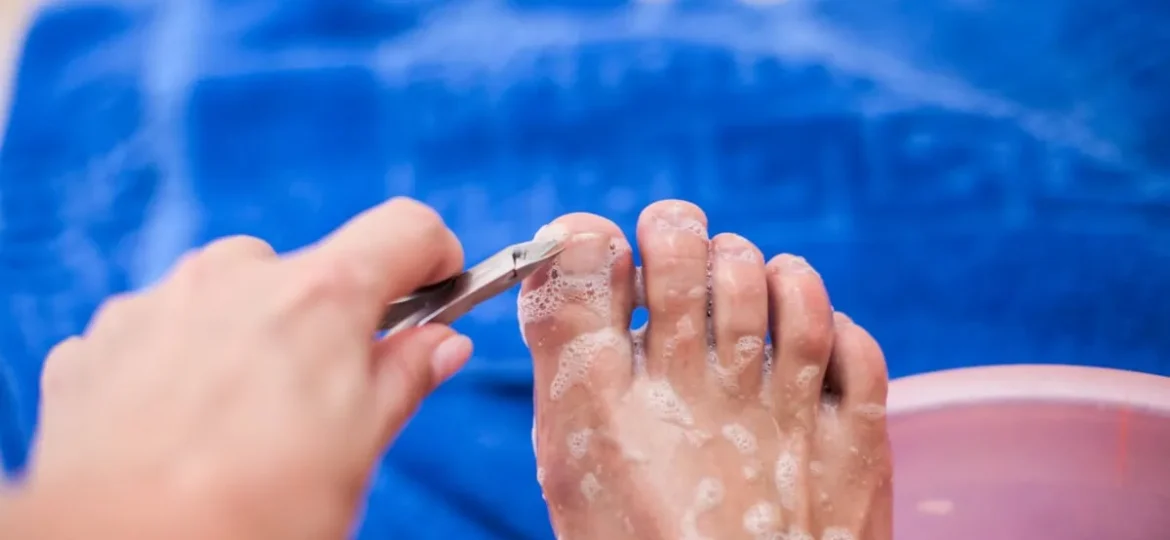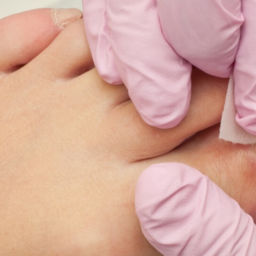
About the Author: Dr. Ashley Bowles ,DPM, FACFAS
Board-certified podiatrist with experience treating foot and ankle conditions. Fellowship-trained in minimally invasive foot surgery and conservative treatment approaches. Member of the American Podiatric Medical Association and specializes in biomechanical foot disorders.
An ingrown toenail occurs when the edge of the nail grows into the surrounding skin, causing pain, redness, and potential infection. As a podiatrist at Certified Foot and Ankle Specialists, I guide patients through effective home remedies, including the therapeutic benefits of warm soaks, while recognizing when professional intervention becomes necessary.
Key Takeaways
- Warm soaks reduce inflammation: Soaking your foot in warm water with Epsom salts for 15-20 minutes three to four times a day helps soften skin and reduce swelling around the affected nail bed
- Early treatment prevents complications: Home remedies work best during the initial stages before infection develops; signs of infection require immediate professional evaluation
- Proper technique matters: Water temperature should be comfortably warm (not hot), and thorough drying afterward prevents bacterial growth
- Professional care is often necessary: While warm soaks provide temporary relief, persistent or infected ingrown toenails typically require podiatric treatment to prevent recurrence
- Prevention is achievable: Cutting your toenails straight across and wearing properly fitted shoes significantly reduces the risk of developing ingrown toenails
Understanding Ingrown Toenails
An ingrown toenail develops when part of the nail penetrates the soft tissues along the nail’s edge. This common condition affects the big toe most frequently, though any toe can be involved. The nail bed becomes irritated as the nail grows into rather than over the surrounding skin.
Several factors contribute to ingrown toenails diagnosed in my practice. Improper nail trimming techniques, particularly rounding the corners too aggressively, rank as the primary cause. Wearing shoes that crowd the toes creates extra pressure on the nail, forcing it into the skin. Genetics also plays a role, as some individuals naturally have nails that curve more dramatically.
Injury to the toe, whether from stubbing or repetitive trauma during athletic activities, can alter how the nail grows. Certain medical conditions affecting circulation or nerve function in the feet increase susceptibility to this painful condition.
The Science Behind Warm Soaks
Warm water therapy serves multiple therapeutic purposes for ingrown toenail care. The heat increases blood flow to the affected area, delivering oxygen and nutrients that support the body’s natural healing processes. Enhanced circulation also helps reduce inflammation and swelling around the nail bed.
Soaking softens both the nail itself and the surrounding skin tissue. This softening effect can provide temporary relief by reducing pressure between the nail edge and inflamed skin. The warm environment also helps draw out minor infections and cleanse the affected area.
Adding Epsom salts amplifies these benefits. The magnesium sulfate in Epsom salts possesses natural anti-inflammatory properties that can help reduce pain and swelling. The salt solution also creates an environment less favorable for bacterial growth.
Proper Warm Soak Technique For An Ingrown ToeNail
To treat an ingrown toenail effectively with warm soaks, follow this evidence-based approach I recommend to my patients.
Preparation Steps:
Fill a clean basin with warm water at a comfortable temperature, testing it with your elbow or wrist before immersing your foot. The water should feel pleasantly warm without causing discomfort or redness. Add one to two tablespoons of Epsom salts per quart of water, stirring until fully dissolved.
Soaking Process:
Soak your foot for 15 to 20 minutes, maintaining water temperature by adding warm water as needed. During this time, avoid aggressive manipulation of the affected toe, which could worsen inflammation or introduce bacteria deeper into the tissue.
Repeat this process three to four times a day for optimal results. Consistency matters more than duration; regular soaking sessions provide better outcomes than occasional longer soaks.
Post-Soak Care:
After each session, dry your foot thoroughly, paying particular attention to the spaces between your toes and around the affected nail. Moisture trapped against the skin creates an environment conducive to bacterial and fungal growth.
Apply a small amount of antibiotic ointment to the affected area if the skin appears broken or shows early signs of infection. Cover with a clean bandage if needed, though allowing air circulation when safely possible often promotes healing.
Complementary Home Remedies
While warm soaks form the foundation of home treatment, several additional strategies can enhance relief and promote healing.
Cotton Wedge Technique:
After soaking and drying, some patients find relief by gently lifting the nail edge and placing a small piece of cotton underneath. This technique should only be attempted if the area isn’t severely inflamed or infected. The cotton helps guide the nail to grow over rather than into the skin.
Replace the cotton after each soak to maintain cleanliness. Never force cotton under the nail if significant resistance is encountered, as this could cause additional trauma.
Footwear Modifications:
Wear open-toed shoes whenever possible to eliminate pressure on the affected toe. When closed shoes are necessary, choose styles with a roomy toe box that doesn’t compress the toes together.
Avoid high heels or narrow shoes that force toes into unnatural positions and increase pressure on the nail bed.
Pain Management:
Over-the-counter pain relievers like ibuprofen or acetaminophen can help manage discomfort while the condition heals. Ibuprofen offers the additional benefit of reducing inflammation. Always follow package directions and consult with a healthcare provider if you have conditions affecting medication choices.
When Home Treatment Isn’t Enough
Despite diligent home care, including regular warm soaks, certain symptoms indicate the need for professional podiatric evaluation. Recognizing these warning signs prevents complications and ensures appropriate treatment.
Infection Indicators:
Increased pain, redness spreading beyond the immediate nail area, warmth to the touch, or pus drainage all suggest infection requiring professional attention. Fever or red streaks extending from the toe warrant immediate medical evaluation.
Persistent Symptoms:
If symptoms don’t improve within three to five days of consistent home treatment, professional assessment becomes necessary. Chronic ingrown toenails often require intervention beyond home remedies.
Underlying Health Concerns:
Individuals with diabetes, peripheral vascular disease, or compromised immune systems should seek professional care promptly rather than relying solely on home treatment. These conditions increase infection risk and can lead to serious complications if ingrown toenails aren’t properly managed.
Professional Treatment Options For An Ingrown Toenail
At Certified Foot and Ankle Specialists, we offer several treatment approaches based on ingrown toenail severity and individual patient factors.
Conservative Office Procedures:
For mild to moderate cases, we can carefully lift the nail edge and place a specialized splint to guide proper growth direction. This office procedure provides immediate relief and often resolves the condition without surgery.
Partial Nail Avulsion:
When conservative measures fail or the condition recurs frequently, partial nail avulsion offers a definitive solution. This minimally invasive procedure removes the problematic nail border under local anesthesia. Recovery typically takes two to three weeks, with most patients experiencing immediate pain relief.
Matrixectomy:
For chronic, recurring ingrown toenails, we may recommend destroying the nail matrix in the affected area. This prevents that portion of the nail from regrowing, providing a permanent solution. The procedure is performed in our office using local anesthesia, and patients usually resume normal activities within days.
Prevention Strategies for Long-Term Foot Care
Preventing ingrown toenails proves far easier than treating them. I emphasize these preventive measures with all my patients.
Proper Nail Trimming:
Cut your toenails straight across rather than following the curve of the toe. Leave nails slightly longer than the tip of the toe, avoiding excessively short trimming that encourages the nail to grow into the skin. Use sharp, clean nail clippers designed for toenails rather than fingernail scissors.
Appropriate Footwear:
Choose shoes that provide adequate room for your toes without crowding. The toe box should allow you to wiggle your toes freely. Replace worn athletic shoes regularly, as compressed toe boxes in older shoes contribute to nail problems.
Regular Foot Inspections:
Examine your feet regularly, noting any changes in nail growth patterns or early signs of ingrown development. Early intervention when you first notice discomfort prevents progression to more painful stages.
Professional Maintenance:
Consider regular podiatric visits if you have difficulty trimming your own nails due to flexibility limitations, vision problems, or thick nails. Professional nail care prevents many complications before they develop.
Recovery Timeline and Expectations
Understanding realistic recovery expectations helps patients maintain appropriate treatment and recognize when their condition isn’t progressing as expected.
Mild Cases:
With consistent warm soaks and proper home care, mild ingrown toenails often improve within five to seven days. Pain should gradually decrease, and inflammation should resolve progressively.
Moderate Cases:
More significant inflammation or early infection may require one to two weeks of dedicated home treatment combined with professional guidance. Improvement should be noticeable within the first few days.
Post-Procedure Recovery:
Following professional treatment, the toe typically heals completely within two to four weeks. Some discomfort during the first few days is normal, but severe or worsening pain warrants contact with your podiatrist.
Conclusion
Warm soaks represent an effective first-line treatment for ingrown toenails when used correctly and consistently. The combination of heat therapy, Epsom salts, and proper foot care often provides significant relief for mild cases. However, recognizing the limitations of home treatment and seeking professional care when needed prevents complications and chronic problems.
At Certified Foot and Ankle Specialists, we partner with patients to determine the most appropriate treatment approach for their specific situation. Whether you need guidance on proper home care techniques or require professional intervention, our experienced team provides comprehensive podiatric care focused on your comfort and long-term foot health.
Don’t let ingrown toenail pain interfere with your daily activities. If home remedies, including warm soaks, haven’t provided relief within a few days, or if you notice signs of infection, contact our office for evaluation. Early professional treatment often prevents more extensive procedures and gets you back to comfortable, pain-free walking quickly.
Remember, proper preventive foot care and prompt attention to early symptoms represent your best defense against ingrown toenail problems. With the right approach and professional support when needed, you can maintain healthy, comfortable feet for all your daily activities.


